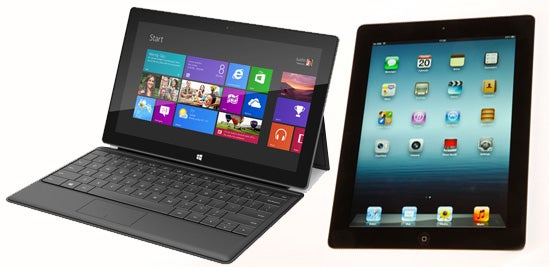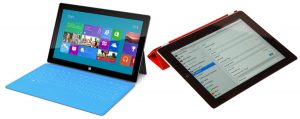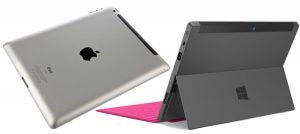Apple iPad VS Microsoft Surface Tablet

From a niche sector that no-one was very interested in, tablets have evolved to become a hotter property than even the average laptop. They’re arguably the new smartphone in terms of momentum, with the most powerful X86 models able to completely replace a laptop.
They come with Android, iOS and even Windows 7. There are 10in, 7in and 5in models. Some have keyboard docks, others pressure-sensitive styli. In short, there’s a lot of variety, but a few stand out. Most recently there’s been the Google Nexus 7, a quad-core stunner that competes with Amazon’s Kindle Fire tablet. However, in all the fuss about this super-affordable yet powerful 7in Android tablet, it’s important not to forget about the massive tablet announcement that preceded it: Microsoft’s Surface.
Read the full review for the Apple iPad 3/New iPad
and our preview of the Microsoft Surface tablet
Being a 10-inch tablet, the Surface’s most obvious competitor is the iPad. But which one should you get if you’re considering a premium tab? One might argue that they’re aimed at different markets, but this is simply not true, at least when comparing the iPad to the Surface RT – which is the more affordable ARM-based version, and as such the one we’ll be mainly comparing against.
However many third-party keyboard accessories are available for Apple’s tablet, the company itself does not sell a portable one in any kind, shape or form. Though Microsoft hasn’t gone all-out and given its Surface tablet a true keyboard dock like the Asus Transformer Pad 300, it will offer no fewer than two different keyboard covers – one with touch ‘keys’, the other with actual physical ones. 
This, along with decent connectivity, make it a far more flexible and productivity-oriented solution than the iPad. However, turning the tables around, there’s little the iPad can do that Microsoft’s tablet doesn’t have the potential to do just as well – even if none of it will look as nice as on the New iPad’s gorgeous Retina display. Of course, the question remains whether app support for Windows RT will match up… With all that in mind, we’re pitting the iPad versus its Microsoft Surface counterpart to see just how they compare in the details.
iPad Versus Surface: Design
From the front both these tablets look very similar – but then the same can be said for 10in tablets in general. What does stand out sharply is the white Windows logo on the front of the Surface, which we feel is a nice touch.
However, from what we’ve seen so far there’s little doubt the iPad is the sleeker- and better-looking tablet overall. That’s not to say the Surface is unattractive, but it sports a somewhat executive look that’s more in tandem with the Lenovo ThinkPad Tablet than the Transformer Prime.
Mind you, we’re all for form over function (within reason), and quite frankly, a more utilitarian body seems like a small price to pay for the extra connectivity and kickstand – the latter being a feature that anyone who has ever tried to watch a movie on their tablet without some kind of case propping it up will doubtless appreciate.
Thanks to its use of a magnesium alloy, the Surface RT is reasonably light at 676g. However, thanks to the extras it packs in it’s a wee bit heavier than most ARM tablets out there. For example, the Transformer Prime weighs 586g, the iPad 2 comes in at 601g, while the New iPad packs the flab at 652g for the Wi-Fi version. On thickness the 9.3mm Surface RT is more impressive, but it still beats the 9.4mm iPad 3 by a kitten’s whisker.
Verdict: Surface Scores
The iPad might be prettier and a little lighter, but the Surface is thinner, packs in more connectivity and an integrated kickstand. Oh, and its magnetic smart cover is also a keyboard, which is a really clever design touch.

New iPad Versus Microsoft Surface Tablet: Connectivity
This one’s pretty straightforward. The iPad (and Google’s Nexus 7, for that matter) simply doesn’t stand a chance. As you may know, aside from its headphone jack the iPad only has a single, proprietary connector. Using an expensive adapter you can hook this up to HDMI for output to a TV/monitor, and using yet another adapter you can read an SD card – but only Apple-approved file formats and you can’t use it to expand storage. As for USB sticks or peripherals, forget it: they just won’t work.
The Surface tablet, on the other hand, has a MicroSD port that can be used to expand its internal memory by 64GB, or to read memory cards from your phone. There’s a microHDMI (mini-DisplayPort on the Surface Pro) port to output to an external display. It also sports a full-size USB 2.0 port (USB 3.0 on the Surface Pro) to hook up keyboards, mice, memory sticks or whatever. When at home you can plug in a hub and easily connect to your desktop setup.
Verdict: Surface Slam-dunks
The iPad will let you connect a few bits, but only with expensive adapters. With Microsoft’s Surface you can hook up all the essentials and then some.

